I am not a botanist or bush scientist what-so-ever, just an intensely inquisitive and somewhat compulsive "snowbirder" in the Mesquite Nevada area; and who is able to read Native Plants of Southern Nevada: an Ethnobotany by David Rhode. These pages are designed simply as a "notepad" of sorts to enable me to try and make sense of what I see around here. So, if you are smarter than I, send comments or corrections; but, I'm not the one to ask questions of.
Succulents:
Desert Plants: Succulents | Cacti | Lg. Shrubs | Sm. Shrubs | Herbaceous | Trees
Joshua Tree (Yucca brevifolia) [Paiute: "tsoadimpi, pe-o-ne (plant); ma-puh-hee (fruit); ma-hou-ve-ga (flower)"]:
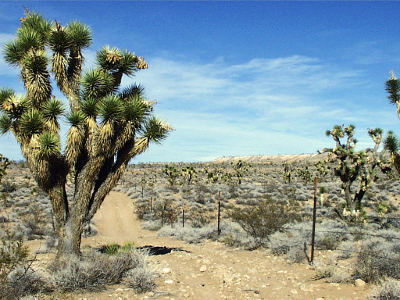
'Three Corners' (Az/Nv/Ut) winter 09
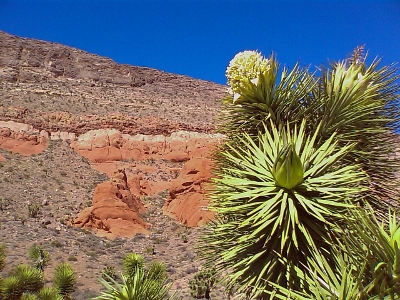
Yucca blooms, Mesquite "North Valley," Spr. 08
Recognition of these plants is not difficult to master, it is the emblem of the Mojave Desert. Their leaves are quite a bit shorter than any of the other succulent types in the area, are nearly always multi-branched and when they flower generate a large wonderful-smelling, cream-colored, sticky blossom about Mar-April. In an enclosed area the fragrance can be overpowering. A concern for the area: finding one of these plants which looks like it is under 20 or so years old is nearly impossible. Not one plant in a thousand is single stalked and/or under about 4 feet! This seems like it could be a problem for the future. The plant does not bloom every year and requires a moth to pollinate it whose larvae feed on the seeds as they hatch.
The fruits are eaten boiled or pit-roasted, like agave hearts, by covering with leaves in a pit lined with coals for two days. A few groups would twist off the tender ends of branches, roast them and eat like an artichoke. Seeds might be eaten like a mush, flowers are sweet, fibers make sandals and other woven goods, and the roots made brown or red design elements in basketry. Additionally young plants were transplanted and husbanded to increase availability.
Mojave Yucca (Yucca schidigera) [S Paiute: "tachumb, u'vimp, uwimpi, chumba (plant); tcimpi (fruits)"]:
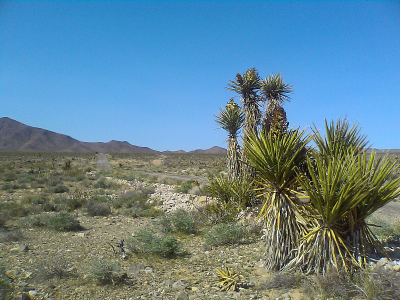
Gold Butte Rd, Spr. '08
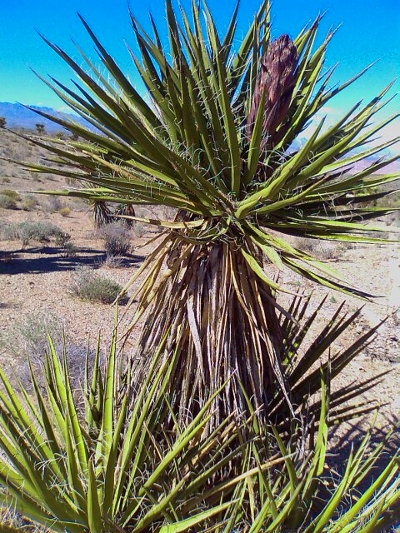
Mesquite North Valley, Spr. '08
[aka Spanish Dagger or Spanish Bayonet] grows 3-15 ft high has trough-shaped, yellow-green leaves up to 3 ft long over trunk and rare side branches. Frayed ends reveal coarse fibers. Flowering spring creamy-white spike is followed by fleshy-green, 2-3 inch long fruit cluster in summer. It is the most common yucca in the Mojave interior and associated with creosote bush-burrobush or saltbush communities.
One of the important "yucca complex" of native foods it was roasted and eaten. Its flowers are sweet and were also eaten as ma-huve-gar. Strong leaf fibers were used for weaving, sewing and fastening into garments and sandals. Pith was used for soap and shampoo and the leaves made a slow match for "relocating" fire. The food and fibers could also be stored.
Bannana Yucca (Yucca baccata) [S Paiute: "u'wivi, kaiuwimpi, uusi; tcimpi (fruits)"]:
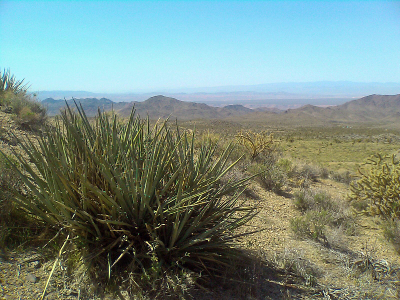
West Bunkerville Flats, Spr. '08
Middle Canyon, Wint. '09
Distinguished by its low, stemless appearance (stems underground), it has a long bluish-gray, spiky-mound of leaves and produces a short central flower spike leading to "bannana-like" fruit pods. It has been confused with "Mojave Yucca" and mistakenly called "Spanish Bayonet." It grows on upper bajadas and slopes of limestone mountains on the margins of the eastern Mojave Desert. It is usually ssociated with other Yuccas, blackbrush, sagebrush and pinyon-juniper woodlands.
An integral part of the "yucca complex" of native foods its fleshy fruits were gathered in the fall, cut into strips and dried. It tasted like sweet, dried apples and could also be ground and used as flour. Its very long leaves produced longer fibers for sewing, weaving and sandal making. Three woven leaves produced a "slow match" for transporting fire. Soap made from fibers and roots was prized because it didn't dry out the basket (or person) and didn't leave an oily residue. It is also used for ceremonial wedding handwashings.
Utah Agave (Agave utahensis) [S Paiute: "yant, nanti, nantapi, yent, yan-da"]:
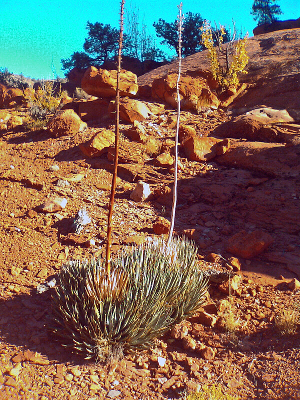
Red Pocket Tanks, Wint. '09
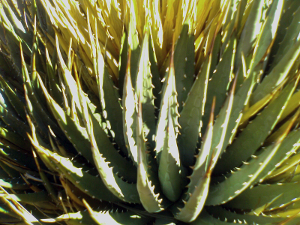
Red Pocket Tanks, Wint. '09
Recognized by a basal rosette of thick bluish leaves about 2 feet in diameter with marginal teeth or spines and an improbably tall thin flowering stalk that possibly exceeding 7 feet. Grows on limestone ridges usually in association with Joshua Trees and shadscale scrub, but also in pinyon and juniper woodlands. It is the most northerly of any Agave species but prefers lowland desert for the warmpth.
An important food source, plants were a "late winter crop" when other food was scarce. Prior to spring bloom, the hearts were collected, when full of sugars, using digging sticks and a mescal knife to cut off leaves. An 8-10 foot, three foot deep, pit was lined with stones heated with fire until coals, topped with communal aagave hearts, topped with grass, juniper bark and earth and let roast for two days accompanied by singing and dancing. The dark, soft, sweet, molasses-tasting hearts were eaten or pressed into cakes for drying and storing. They made a good travel food which was laxating to the uninitiated. Lazily the whole plant could be roasted and eaten like an artichoke, discarding the tough stringy parts. Leaves were said to taste like "burned sugar" and historically fibers were used as gun wads.
Desert Plants: Succulents | Cacti | Lg. Shrubs | Sm. Shrubs | Herbaceous | Trees